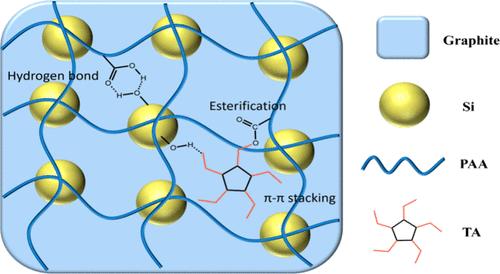高性能锂离子电池硅碳阳极的定向锚定交联粘结剂
IF 3.2
3区 化学
Q2 CHEMISTRY, PHYSICAL
引用次数: 0
摘要
硅基材料由于其较高的理论容量而成为锂离子电池的阳极材料。然而,硅在循环过程中的大量体积膨胀带来了诸如颗粒粉碎和不稳定固体电解质界面(SEI)形成等挑战。本研究开发了一种具有定向锚定机制的原位热交联聚丙烯酸-单宁酸(PLT)粘合剂,以解决硅碳(Si/C)阳极体积膨胀引起的问题。通过将单宁酸(TA)加入到锂化聚丙烯酸(PAALi)基体中,构建了一个具有双相互作用机制的定向锚定交联网络:TA的芳香部分与石墨碳层建立了强大的π -π堆叠相互作用,而PAALi的羧基与硅的表面羟基形成共价酯化键、氢键和离子偶极子相互作用。这种分子尺度定向锚定策略显著提高了电极的界面结合强度(180°剥离力为2.6 N),并赋予电极优异的机械稳定性(弹性模量为6.03 GPa)。电化学测试表明,Si/C@PLT电极具有优异的初始放电容量(1137.7 mAh/g)和100次循环后的容量保持率(90.02%)。这项工作为硅基复合材料的粘结剂设计提供了一种新的分子工程策略,突出了界面定向锚定在提高高容量电极循环稳定性方面的关键作用。本文章由计算机程序翻译,如有差异,请以英文原文为准。

Directional Anchoring Cross-Linked Binder for High-Performance Silicon–Carbon Anodes in Li-Ion Batteries
Silicon-based materials have garnered significant attention as anodes for Li-ion batteries due to their high theoretical capacity. However, the substantial volume expansion of silicon during cycling poses challenges such as particle pulverization and unstable solid electrolyte interface (SEI) formation. This study developed an in situ thermally cross-linked poly(acrylic acid)-tannic acid (PLT) binder with directional anchoring mechanisms to address the problems caused by volumetric expansion of silicon–carbon (Si/C) anodes. By incorporating tannic acid (TA) into the lithiated poly(acrylic acid) (PAALi) matrix, a directionally anchored cross-linked network with dual-interaction mechanisms was constructed: the aromatic moieties of TA establish robust π–π stacking interactions with graphitic carbon layers, while the carboxyl groups of PAALi form covalent esterification bonds, hydrogen bonds, and ionic dipole interactions with surface hydroxyl groups of silicon. This molecular-scale directional anchoring strategy significantly enhanced interfacial binding strength (180° peeling force of 2.6 N) and endowed the electrode with exceptional mechanical stability (elastic modulus of 6.03 GPa). Electrochemical tests demonstrated that the Si/C@PLT electrode delivered superior initial discharge capacity (1137.7 mAh/g) and capacity retention (90.02% after 100 cycles). The work provides a novel molecular engineering strategy for binder design in silicon-based composites, highlighting the critical role of interfacial directional anchoring in enhancing cycling stability for high-capacity electrodes.
求助全文
通过发布文献求助,成功后即可免费获取论文全文。
去求助
来源期刊

The Journal of Physical Chemistry C
化学-材料科学:综合
CiteScore
6.50
自引率
8.10%
发文量
2047
审稿时长
1.8 months
期刊介绍:
The Journal of Physical Chemistry A/B/C is devoted to reporting new and original experimental and theoretical basic research of interest to physical chemists, biophysical chemists, and chemical physicists.
 求助内容:
求助内容: 应助结果提醒方式:
应助结果提醒方式:


